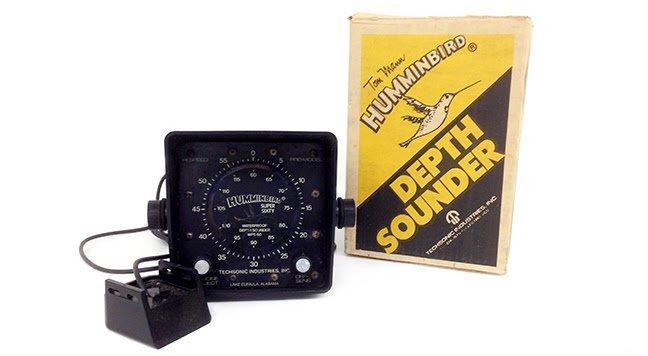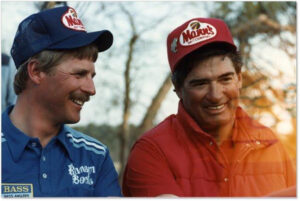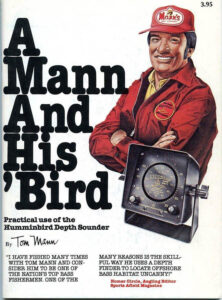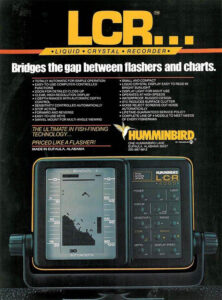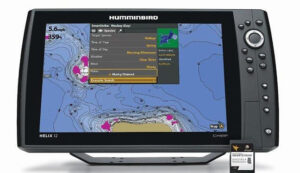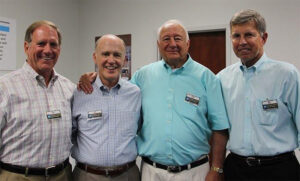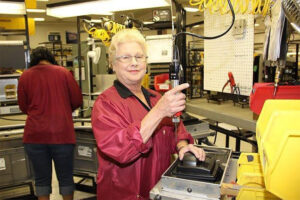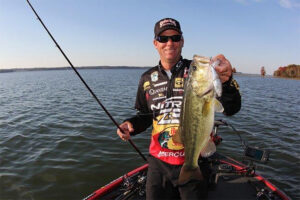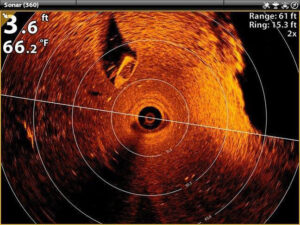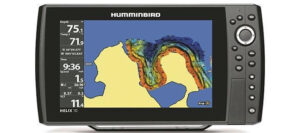The old saying goes, “It takes a village to raise a child.” Much the same is true when it comes to ‘raising a company.’ Many individuals must combine unique gifts and unify a team in order to shepherd a vision into real success. In the case of Humminbird, there were so many that contributed to the present day leadership position in the market. From early visionaries, engineers, factory workers, dealers, to customers, all melded together to shape not only a company, but an industry. And after more than 40 years, Eufaula, Alabama is still home to Humminbird’s engineering, manufacturing and technical support. For us at Wired2Fish, Humminbird has always been one of the best fish finder brands in the world.
This is a story of American ingenuity, passion and perseverance as told through the recollections of the fishing industry pioneers who lived it. Now, the next time someone walks into your shop you can share not only the best of technology and performance but the story of how Humminbird earned its wings.
Humble Beginnings
Like many iconic American companies, fishing electronics manufacturer Humminbird has humble beginnings. Hatched in a modest Eufaula, Alabama, garage-like facility in 1971, Tom Mann and a handful of investors known as Allied Sports Company began modifying Heath Kits into the first Humminbird Depth Sounders.
Former Humminbird CEO Jim Balkcom recalls: “Around 1970 there was a Eufaula Hospital radiologist making changes to the electrical design of Heath Kit Depth Sounders to shield interference from the bigger outboards making their way onto bass boats. Tom Mann was impressed and they started placing foil over the Heath Kit logo and selling the modified units to a buddy here, a buddy there. Before they knew it, they were creating serious demand.”
Longtime Humminbird pro Hank Parker loves to tell the story of how Humminbird got its name.
What’s In a Name?
One of the most entertaining stories of Humminbird’s early years involves how the company got its name. Longtime Humminbird pro Hank Parker knows the story well, having spent a great deal of time with the brand’s pioneers.
“As a great structure fisherman, Tom Mann had a real need for a good depth finder, so he was excited about what those first modified units could do compared to what was available. So Tom approached his investor buddy Jim Murphy of Eufaula’s American Builders: ‘You gotta see this thing! It’s going to revolutionize fishing!’ Tom took Jim out on the water and Jim was impressed. ‘I think you’ve got a winner, Tom. Count me in. But what are your going to call it?’ Tom replied, ‘I’m gonna call it Humminbird, I’ve already filed for registration.’ And Jim said, ‘No Tom, you can’t get registration on a common name, that’s public domain.’ Tom shook his head, ‘They better register it. I already sent them my $300!’ About two weeks later Tom got the registration papers in the mail, and he walked into Jim Murphy’s office: ‘Looky here, I got it!’ Murphy inspected the papers and smiled, ‘Tom, that was absolutely brilliant, leaving the ‘g’ out of hummingbird.’ Tom laughed: ‘I didn’t know it had a ‘g’ in it. I ain’t never heard of no humming-bird in my life. My momma always called it ‘humminbird!’”
As to why they chose to name the brand after a tiny bird, former Humminbird PR Manager, Larry Columbo, explains: “As I understand it, Tom Mann and the guys were sitting around a table throwing around brand names when somebody said, ‘What’s the fastest bird that flies? Tom Mann, also an Alabama game warden, jumped in, ‘That’d be the Humminbird!’ Tom had a real thick drawl and couldn’t pronounce the ‘g’ either!”
Still others say the name refers to the “humming” sound the early Depth Sounders produced when in operation. But whatever the reason, the name stuck. Since, it’s become synonymous with fish-finders, like Kleenex is to tissue paper.
The Super Sixty Years
Soon the expanding group of angel investors recruited an electrical engineer and Eufaula, Alabama native named Yank Dean IV. Yank left a post at Texas Instruments in Dallas and moved back to Eufaula to oversee engineering and assume the role of CEO. As volume increased, Dean began sourcing parts and set up a production line of six people. Then, in 1975, Humminbird introduced the first-ever waterproof depth sounder, the Humminbird Super Sixty, which became one of the best-selling fishfinders ever produced, altered the trajectory of sport fishing forever. Sales numbers grew exponentially and an entire new market segment was born.
Humminbird’s stable of pro anglers quickly expanded to include Bill Dance, Jimmy Houston, Hank Parker, Al Lindner, and numerous others. Through print, TV and tournaments, the team taught average anglers how to locate and catch fish faster, creating significant brand buzz.
Al Lindner remembers the day he joined the team. “I had just finished competing in the 1975 Bassmaster Classic on Currituck Sound, North Carolina, and I sat next to Yank Dean on the bus back from dinner. By the time we got to the hotel, I was a ‘Bird man! You needed a good piece of electronics to do your job and the Super Sixty was reliable and easy to read. Same reasons I’m still with Humminbird today.”
Almost overnight, the business grew to $1.5 million, leading investors to recruit a COO to work with Yank Dean IV as CEO. That position would be filled by Jim Balkcom, a West Point and Harvard Business School grad who had served in Vietnam.
Balkcom recalls: “In October 1976 I showed up at the Eufaula Holiday Inn in my fancy three-piece pin-striped suit, and here Yank rides up on his motorcycle in jeans, a cowboy shirt, wooden beads around his neck, and full beard. We hit it off the way opposites attract. Yank’s eyes twinkled; he was a classic entrepreneur. So, the next 20 years I got to wear jeans and a baseball hat to work instead of a suit.”
Then, in October of 1977, the company lost its CEO. “One Saturday morning Yank and I were out jogging on opposite ends of Eufaula and somebody pulled up alongside me and said Yank Dean had just dropped dead in the middle of the road. He passed away at age 42 from a congenital heart defect, which left me in a leadership position of 13 employees. I looked at the board of directors and said, ‘I’m not much, but I’m all you got,’” says Balkcom.
Pushing Forward
The tragedy pushed the team to work even harder and by the end of 1977 Humminbird inched towards #1 in the marine electronics market and the company adopted a new name, Techsonic Industries, Inc. While the Humminbird Super Sixty was a new industry standard, Balkcom wasn’t one to rest on his laurels. “I knew we’d have to do something disruptive to build the brand,” says Balkcom.
But first, he’d need to establish a senior leadership team and acquire some ownership in the company. “I hired Tom Dyer, a classmate of mine at West Point who was the best marketing guy on the planet. Then I hired Bill Moorer, the captain of Bobby Dodd’s last football team at Georgia Tech as COO.”
Then came the leveraged buy-out. “My wife and I walked down to the bank, I took my $35,000 network, and we signed a $14 million note with North Carolina National Bank and bought out the original investors and funded the company going forward. Tom, Bill and I each had 25% of the company and each of us put 20% of our company stock into an Employee Stock Options Plan (ESOP). If that day came – and it did – we wanted the folks pulling the wagon to share in the prosperity.”
Humminbird Listens to Customers
Balkcom admits that the first nine products he introduced didn’t do so well. So, in 1981 or 1982, he did something ‘disruptive.’ “The Humminbird Super Sixty was getting a little tired. But instead of asking our pros, dealers, distributors, and field testers what our next product and technology should be, we went straight to the customer, which was pretty revolutionary at the time.
He says the preconceived notion was that anglers wanted fancier fishfinders with “more buzzers and whistles.” Surprisingly, what came back was just the opposite. “Fishermen wanted less complicated and easier-to-use units they could read in bright sunlight. We decided to bet the farm on it. Luckily, it paid off.”
Balkcom tasked engineers to work on a display that could be read in bright sunlight. By 1984, they unveiled the LCR series, the industry’s first Liquid Crystal Display (LCD) fish-finder. “We introduced the first fish-finder that used a microprocessor to process signals, so we were able to display a chart-like appearance on an LCD screen that could be seen in bright sunlight with only two buttons on it. One button turned it on and off and the other sequenced through features. It was that simple. And it took off like a rocket ship. We went from $6 million to $75 million in revenues within three years and grew from 0% to 48% market share, revolutionizing the industry.”
Not long after the birth of the first LCD unit, Balkcom went back to Humminbird customers again.
“We sent out questionnaires to every angler who’d filled out a warranty card asking what they wanted in a follow-up unit. Fishermen wanted a unit that could distinguish fish from the bottom, rocks, and other clutter. So we went to Hitachi and brought home a recently-developed two-color display. Our engineers then figured out how to make the display show fish in red. The next year we came out with the LCR4ID. Our byline was ‘If it’s a fish, it’s red’.”
By 1987, the Humminbird LCR 4ID fishfinder became the #1 selling product in both the sport fishing and marine industries. Humminbird PR manager during this time, Larry Columbo, recalls: “The LCR 4ID became so popular that we’d build and ship the same day. We never put one in inventory for 18 months. Bass Pro Shops wanted to buy out the entire production but Tom Dyer, our VP or marketing and sales, said everybody gets their fair share. It was one of those deals where Bass Pro had customers putting money down on promised units, they were so popular.”
The era of the LCR 4ID saw Humminbird employees working 50 to 70 hours a week to keep up with product demand. “One Friday Dyer got on the PA system and told everyone to quit what they were doing and meet at the front door. There was Dyer with a black garbage bag full of $100 bills. As you walked through the door he shook your hand, gave you two $100 bills and said, ‘Here, have a nice weekend, see you Monday morning!’ He did that at least two different times. That’s how busy the company was during that period of time—and how much the company valued its employees,” says Columbo.
A Very Bright Day in Eufaula, Ala.
Around the same time came the happiest day of Balkcom’s business career. “In 1987 we decided to liquidate the employee stock ownership plan. We handed out checks to our 250 employees that totaled about $7 million. Keep in mind, these were rural Alabama workers. This gave them the opportunity to buy their first homes, cars and send their kids to college. It was probably the happiest day of my life,” says Balkcom.
To this day, all Humminbird employees work as a ‘family,’ from upper management to factory staff. Many who bought their first homes and cars when the company liquidated its ESOP still work there today.
The timing couldn’t have been better to reward Humminbird employees. From 1989 to 1991, the combined effects of the recession and a new luxury tax shrank the boating and marine industries by over 50%. “We came very close to burying the company. But thanks to large vendors like Bass Pro Shops and Wal-Mart, we survived,” recalls Balkcom.
As a result, Humminbird weathered the downturn and the brand continued with new innovations, including the revolutionary introduction of the first 3-D sonar, the Dimension 3-120. Teleflex Incorporated of Limerick, Pennsylvania, noticed the company’s success, and in 1993 partnered with Techsonic to create the Humminbird WIDE series, what would become one of the most successful product launches in Techsonic history. That year, Techsonic officially became a “Teleflex Company.” And in December 1994, after nearly 20 years with Humminbird, Jim Balkcom retired.
Now passing the baton, the company was poised for some of its biggest innovations yet. But there would be significant, almost show-stopping hurdles in order to get there.
The New Millennium
The new millennium began with the kind of continued innovation that’s become synonymous with Humminbird. In 2002, the Piranha series of entry-level fishfinders as introduced, and in 2003, SmartCast wireless technology opened the market to all anglers, even those fishing from banks, docks and smaller boats. Later that year, the Matrix Fishing Systems launched, providing advanced sonar, chartplotting and GPS capabilities for professional anglers.
In mid-2004, Johnson Outdoors acquired Techsonic Industries. Known for its spirit of adventure and legacy of innovation, Johnson Outdoors proved the perfect complement to the Humminbird brand.
As Helen Johnson-Leipold, Chairman and Chief Executive Office of Johnson Outdoors has stated: “An even greater future lies ahead, as we look to leverage this formidable combination of cutting-edge technology and consumer-insight excellence to drive growth in the marine electronics marketplace.
Following the acquisition by Johnson Outdoors, growth over the past decade has been impessive. The company’s innovations include countless patented technologies and industry firsts, including the first 630 vertical pixel LCD display available to anglers in 2004 and the first consumer Side Imaging Sonar System in 2005. Perhaps no technology other than the birth of sonar and GPS has had a more far-reaching impact on the sport of fishing than Humminbird’s patented Side Imaging.
Not long after its introduction, four-time Bassmaster Classic champion and seven-time Angler of the Year Kevin VanDam started winning tournaments with the help of the new technology, including 2010’s Bassmaster Classic in Birmingham, Alabama, and 2011’s Classic in the Louisiana Deltas near New Orleans, Louisiana. These exalted back-to-back wins proved Side Imaging technology had the power to give an already outstanding angler an even bigger advantage. Customers followed suit and learned to use the technology to find an catch fish faster than ever before.
Along the way, Humminbird worked hard to demonstrate how its products and technologies could help all anglers, not matter the boat size, target species or conditions. For example, Humminbird earned praise from ice anglers by introducing the first flasher with dial-mounted LCD, digital depth and auto scale (ICE-35, ICE-45 and ICE-55) in 2008, still considered best-in-class today. Then, in 2009, Humminbird came to market with the first 640V x 640H 5-inch display, represented in 778, 788 and 798 sonar units.
In a bold move to bolster the mapping capabilities in their GPS-enabled fish finders, Johnson Outdoors Marine Electronics, Inc. acquired LakeMaster digital GPS mapping in 2011. The LakeMaster team continues to operate from its facility in Little Falls, Minnesota, where they’ve developed groundbreaking cartography products like AutoChart and SmartStrike, which allow anglers to map their own waters and predict fish patterns.
The Birth of 360 Imaging
2012 was a big year for Humminbird, as they launched another industry-first technology. The release of 360 Imaging rocked the fishing world, providing anglers with a full 360 degrees of underwater viewing – 150 feet in every direction around the boat. A year later, Bow 360 was introduced, offering anglers the powerful new technology in a version easily clamped to bow-mount trolling motors. The best anglers in the professional bass world were first to sing its praises, including Kevin VanDam, who heralded it as “underwater Superman X-ray vision.”
“The average angler doesn’t understand just how proficient this technology makes you,” says VanDam. “In the past all I could interpret was what 2D sonar was showing me. Is that a tree, grass, what exactly is that? Now, running any combination of 360 Imaging, Side Imaging, Down Imaging, 2D SONAR, and Lakemaster mapping together on the same screen, it’s much easier to tell exactly what you’re looking at – and reveal the fish that are relating to that cover.”
Along the way, everyone from the fishing media, ICAST, NMEA to Popular Science magazine showered 360 Imaging with awards.
At the 2014 Ft. Lauderdale International Boat Show another landmark introduction was made in the form of ONIX and ION, the only sonar and multi-function displays (MFDs) in their space with full keypad and touch screen operation. Later that year ONIX won “Best of Electronics” at ICAST.
In November 2014 Humminbird launched Helix 5, the first in a new family of fishfinders with an ultra-bright screen, pro-level features, and a real-world price. In 2015 the company followed with Helix 7 – and most recently, Helix 9, 10 and 12 CHIRP models. The 9, 10 and 12 brought anglers advanced cartography in the form of AutoChart Live, which allows anglers to make their own high-definition lake maps, no PC, cloud or server upload required. Just this past February 2016, Humminbird announced a free Helix 9, 10, and 12 upgrade that allows compatibility with their SD card-based predictive fish patterning software called SmartStrike.
The innovations continue as you read this. Consider the recent acquisition of digital cartography specialists Northport Systems, Inc. by Johnson Outdoors, an exciting move that spells more high-tech mapping capabilities for anglers.
“Innovation is what consumers demand, customers expect and Johnson Outdoors has delivered consistently for nearly 50 years. We are pioneers in fishing electronics—from electric trolling motors… to wireless remote steering and navigation … to revolutionary Side Imaging sonar… and more,” says Helen Johnson-Leipold. “Our ability to deliver new products that enhance the outdoor recreational experience is critical to our continued success. Northport brings new cartography capabilities which can broaden our innovation horizon, accelerate speed-to-market and further enhance potential for bigger new-product success and sustained growth in our global fishing brands.”
American Soil
Even more remarkable, Humminbird innovations and technologies can be traced back to American soil. The factory is still locate in Eufaula, Alabama, home to its humble beginnings over 40 years ago. In 2014 Humminbird closed its satellite office in Shanghai, China, and moved the operation to Alpharetta, Georgia, hiring U.S. engineers to fill those jobs.
Fact is, from design to manufacturing, Humminbird is a company that embodies American vales. Employee tenure is long and morale is high. It’s a place where people take pride in what they do.
“Johnson Outdoors identified early on that a U.S.-based operations facility is key to their strategic plan and overall success. Investments made in technology, equipment, processes, and people have driven consistent year-over-year improvements and allowed us the flexibility and structure to react to the marketplace as needed. These investments, coupled with our people and the core values of Johnson Outdoors, make the facility a preferred place to work and results in a stale, committed workforce, that think of themselves as ‘family,’ and is capable of great things,” says Humminbrd Manufacturing General Manager Craig Packard.
This ‘family’ corporate culture and ongoing investment in people and processes are just a couple of the reasons why Humminbird keeps growing and gaining market share. Landmark technologies are a big part of that too, which not only help anglers find and catch fish faster, but do so with an unprecedented ease of use.
“We challenge every step, every role in manufacturing capacity to ensure we have the highest output, most efficient cost structure possible while simultaneously investing in our people,” says Packard.
And, get this: The company is profitable.
Naysayers would have you believe that companies can’t design and manufacture cutting-edge electronics in America. But by investing in American engineering and manufacturing, Humminbird is proving not only that it can be done, it can be done while extending more quality and value to the customer.
“Our goal is to provide landmark technologies at the right price, while raising the bar for the industry,” says Humminbird Brand Manager, Jeff Kolodzinski. “But the design and manufacture of best-in-class products is only possible by great people supported with strong and efficient systems. We challenge them every day to make sure we’re operating as effectively as possible.”
Packard comments: “Each Humminbird employee is empowered to provide insights about what could make things better and more cost effective. It’s a culture of success and accountability, and employees know their skill sets and expertise matters.”
The same is not only true of Humminbird’s engineering, design and manufacturing but the company’s customer and technical support divisions, also housed on the Eufaula, Alabama, campus.
Ask anglers about the Humminbird experience and stellar customer service is routinely mentioned. From short call wait times to online technical support chat to repairs within 72 hours at the factory service facility, Humminbird prides itself on providing the very best customer support available.
Senior Customer Service Manager Rhonda Green has been with the company for nearly 30 years and directs a blend of full- and part time staff. The full-time staff outnumbers the seasonal staff and boast an average of 16 years of learning an service at Humminbird. That sort of experience just doesn’t happen in the customer service realm. It’s a testimony to the leadership and culture in Eufaula.
“We’re always looking for better ways to serve the customer. Not only do we offer customer and technical support, but we’re heavily involved in the development of Humminbird’s website, including the implementation of online Live Chat technical support. We’re also constantly updating the FAQs section to ensure customers can self-serve and get the information they need, whether it’s making the most of Humminbird unit features or ordering sonar accessories. And that’s just in addition to maintaining a call center that prides itself on getting a live person on the call ASAP.”
Going one step further, the Humminbird Select Program, available to owners of ONIX/ION and HELIX 9, 10 an 12 units, offers several value-added benefits like a special toll-free number that goes straight to the highest skilled rep without any prompts or call wait time. These customers also receive notifications of special training sessions and automatic e-mails when new system software update are available.
“We know our customers’ time on the water is precious so we do our very best to answer their questions, solve their technical issues or repair and return product, so they can get back to fishing,” says Green.
While Humminbird’s American heritage and rise from humble beginnings into a global player is fascinating telling of the American Dream, the rubber hits the road in retail. If customers don’t see the benefits, well, a company might a well move production offshore. And many have.
But all indications point to Humminbird investing in its customers, too. They’re putting their money where their mouth is, so to speak. Case in point, the company’s recently-launched HELIX 9 and 10 units feature the latest in pro-level technologies but are reasonable priced from $699.99 to $1499.99.
That is a bold statement in an industry that has priced many anglers out of cutting-edge fishing electronics.
“At the end of the day, Humminbird is committed to creating and keeping jobs in the U.S., and helping customers around the world find and catch more fish,” says Kolodzinski.
That in mind, I think we can all look forward to more exciting chapters in the story of America’s favorite fishfinder.


